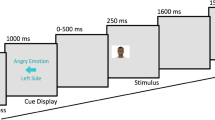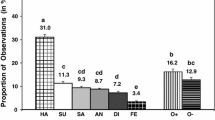Abstract
In a sample of 325 college students, we examined how context influences judgments of facial expressions of emotion, using a newly developed facial affect recognition task in which emotional faces are superimposed upon emotional and neutral contexts. This research used a larger sample size than previous studies, included more emotions, varied the intensity level of the expressed emotion to avoid potential ceiling effects from very easy recognition, did not explicitly direct attention to the context, and aimed to understand how recognition is influenced by non-facial information, both situationally-relevant and situationally-irrelevant. Both accuracy and RT varied as a function of context. For all facial expressions of emotion other than happiness, accuracy increased when the emotion of the face and context matched, and decreased when they mismatched. For all emotions, participants responded faster when the emotion of the face and image matched and slower when they mismatched. Results suggest that the judgment of the facial expression is itself influenced by the contextual information instead of both being judged independently and then combined. Additionally, the results have implications for developing models of facial affect recognition and indicate that there are factors other than the face that can influence facial affect recognition judgments.




Similar content being viewed by others
Notes
Whereas a log linear transformation was conducted on RT data to correct for skewness/kurtosis, the skewness/kurtosis of the accuracy data was within normal range. Therefore, no data transformation was conducted on accuracy data.
The mismatch score was calculated by averaging across all of the different mismatching emotional contexts (e.g., for a sad facial expression, mismatching emotional contexts would be happy, fear, and disgust expressions).
The particular emotion used as context had a large effect on RTs (average Cohen’s d = 1.12), whereas it had only a small effect on accuracy (average Cohen’s d = .25). Consequently, to illustrate the effect of the degree to which match versus mismatch of context influenced RTs, we adjusted the RTs based on the average RT for each individual context emotion. For example, the adjusted RT for disgust faces with matching context was computed as the average RT for disgust faces with disgust context divided by the average RT for all faces with disgust context.
References
Bozikas, V. P., Kosmidis, M. H., Anezoulaki, D., Giannakou, M., & Karavatos, A. (2004). Relationship of affect recognition with psychopathology and cognitive performance in schizophrenia. Journal of the International Neuropsychological Society, 10(4), 549–558.
Carroll, J. M., & Russell, J. A. (1996). Do facial expressions signal specific emotions? Judging emotion from the face in context. Journal of Personality and Social Psychology, 70(2), 205–218.
Darwin, C. (1872). The expression of the emotions in man and animals. London: John Murray.
Ekman, P. (2003). Emotions revealed: Recognizing faces and feelings to improve communication and emotional life. New York, NY: Times Books/Henry Holt.
Ekman, P., & Friesen, W. V. (1975). Unmasking the face: A guide to recognizing emotions from facial clues. Oxford: Prentice-Hall.
Elfenbein, H. A., & Ambady, N. (2002). On the universality and cultural specificity of emotion recognition: A meta-analysis. Psychological Bulletin, 128(2), 203–235.
Felmingham, K. L., Bryant, R. A., & Gordon, E. (2003). Processing angry and neutral faces in post-traumatic stress disorder: An event-related potentials study. Neuroreport: For Rapid Communication of Neuroscience Research, 14(5), 777–780.
Fernberger, S. W. (1928). False suggestion and the Piderit model. American Journal of Psychology, 40, 562–568.
Fridlund, A. J. (1994). Human facial expression: An evolutionary view. San Diego, CA: Academic Press.
Golden, C. J. (1978). Stroop color and word test: A manual for clinical and experimental users. Wood Dale, IL: Stoelting.
Goodenough, F. L., & Tinker, M. A. (1931). The relative potency of facial expression and verbal description of stimulus in the judgment of emotion. Journal of Comparative Psychology, 12(4), 365–370.
Hess, U., Blairy, S., & Kleck, R. E. (1997). The intensity of emotional facial expressions an decoding accuracy. Journal of Nonverbal Behavior, 21, 241–257.
Hofmann, S. G., Suvak, M., & Litz, B. T. (2006). Sex differences in face recognition and influence of facial affect. Personality and Individual Differences, 40(8), 1683–1690.
Hugenberg, K. (2005). Social categorization and the perception of facial affect: Target race moderates the response latency advantage for happy faces. Emotion, 5(3), 267–276.
Kerns, J. G., & Berenbaum, H. (2000). Aberrant semantic and affective processing in people at risk for psychosis. Journal of Abnormal Psychology, 109, 728–732.
Kim, H., Somerville, L. H., Johnstone, T., Polis, S., Alexander, A. L., Shin, L. M., et al. (2004). Contextual modulation of amygdala responsivity to surprised faces. Journal of Cognitive Neuroscience, 16, 1730–1745.
Landis, C. (1929). The interpretation of facial expression in emotion. Journal of General Psychology, 2, 59–72.
Lang, P. J., Bradley, M. M., & Cuthbert, B. N. (1999). International affective picture system (IAPS): Technical manual and affective ratings. Gainesville: Center for Research in Psychophysiology.
Leppänen, J. M., & Hietanen, J. K. (2003). Affect and face perception: Odors modulate the recognition advantage of happy faces. Emotion, 3(4), 315–326.
McClure, E. B., Pope, K., Hoberman, A. J., Pine, D. S., & Leibenluft, E. (2003). Facial expression recognition in adolescents with mood and anxiety disorders. American Journal of Psychiatry, 160(6), 1172–1174.
Munn, N. L. (1940). The effect of knowledge of the situation upon judgment of emotion from facial expressions. The Journal of Abnormal and Social Psychology, 35(3), 324–338.
Nachson, I. (1995). On the modularity of face recognition: The riddle of domain specificity. Journal of Clinical and Experimental Neuropsychology, 17(2), 256–275.
Parke, F. I., & Waters, K. (Eds.). (1996). Computer facial animation. Wellesley, MA: A K Peters.
Righart, R., & de Gelder, B. (2008a). Recognition of facial expressions is influenced by emotional scene gist. Cognitive, Affective & Behavioral Neuroscience, 8(3), 264–272.
Righart, R., & de Gelder, B. (2008b). Rapid influence of emotional scenes on encoding of facial expressions: An ERP study. Social Cognitive and Affective Neuroscience, 3(3), 270–278.
Spencer-Smith, J., Wild, H., Innes-Ker, Å. H., Townsend, J., Duffy, C., Edwards, C., et al. (2001). Making faces: Creating three-dimensional parameterized models of facial expression. Behavior Research Methods, Instruments & Computers, 33, 115–123.
Sullivan, S., Ruffman, T., & Hutton, S. B. (2007). Age differences in emotion recognition skills and visual scanning of emotion faces. Journals of Gerontology. Series B, Psychological Sciences and Social Sciences, 62B(1), P53–P60.
Acknowledgments
The authors would like to thank Jesse Spencer-Smith, Ph.D., for his valuable comments and suggestions to help improve this manuscript.
Conflict of interest
None.
Author information
Authors and Affiliations
Corresponding author
Rights and permissions
About this article
Cite this article
Milanak, M.E., Berenbaum, H. The effects of context on facial affect recognition. Motiv Emot 38, 560–568 (2014). https://doi.org/10.1007/s11031-014-9401-x
Published:
Issue Date:
DOI: https://doi.org/10.1007/s11031-014-9401-x




